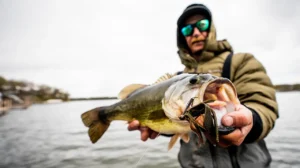On March 28, New Jersey angler Bob Robertson had the hookup of a lifetime fishing the lower stretches of the Delaware River. The seasoned angler was working a Rapala X-Rap along a slower stretch of the river when it was attacked by an unfamiliar species that some are saying is a new hybrid of the country’s most popular game fish and an invasive species.
“Well, it just hit like a ton of bricks,” said Robertson. “It pulled like nothing else I’ve ever caught in the river. I knew immediately it was something different.”
Robertson didn’t know how right he was. After a 10 minute battle that he described as “epic,” he had an otherworldly-looking fish at his feet. It taped out to an impressive 33 inches and was bigger than anything he’d ever pulled from the river, but it certainly wasn’t like any fish he’d encountered before.
“I had never seen anything like it. I know that there’s snakeheads in here, but it didn’t look quite right,” Robertson told Wired2Fish. “I called the DEP to let them know about the weird fish. I’m not sure they believed me, so they asked me to send them a picture and hang on to the fish.”
Robertson had the fish in a cooler, and he secured the lid with a bungee cord to keep it from escaping. Not five minutes after Robertson emailed the photo his phone rang. The New Jersey Department of Environment Protection’s (NJDEP) Fish & Wildlife division asked him to hang tight, and said they were dispatching a biologist to his location.
“I wasn’t quite sure what to make of it from the photo,” NJDEP Fisheries biologist Dr. Frank DiCiccio told Wired2Fish. “We’ve had snakeheads in that section of the river for years, but it just seemed off.”
Once he saw the fish in person, his suspicions were confirmed: this could be the first example of a snakehead-largemouth bass hybrid.
“I’ve been working in fisheries for almost 30 years, but this is a first for me,” DiCiccio said. “The tail was all snakehead, but the actual head of the fish, its gill structure, and the first segment of its body was unmistakably largemouth. It sure looks like a cross between the two, but we won’t know what’s what until a thorough DNA analysis can be done.”
DiCiccio said Robertson has lent the fish to state biologists to conduct the necessary testing.
Snakeheads were first identified in the Delaware River watershed in July 2004. Since that time, they have expanded their range, being found in many more area waterways, explains DiCiccio. Most of them are northern snakeheads (Channa argus), which are native to temperate regions of Asia. In contrast, the largemouth bass (Micropterus salmoides) is native to the United States, southeastern Canada and northern Mexico. They have been in the Delaware River for as long as records have been kept.
Largemouth have been known to hybridize with other members of the centrarchid family, such as the warmouth (Chaenobryttus gulosus), spotted bass (Micropterus punctulatus), and members of the crappie family (Pomoxis spp.). But hybridization outside of those few circumstances is very unusual.
In a paper published by the Illinois Natural History Survey, the author notes that, “natural hybridization occurs quite commonly between certain species within certain tribes; however, natural intertribal hybridization is quite rare.”
So, how can the apparent snakehead/largemouth hybrid caught by Robertson be explained?
“Life finds a way,” says DiCiccio. For more information and more photos of this bizarre fish, check this out right away.












